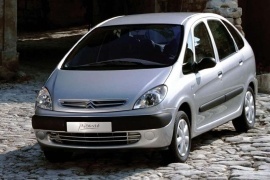
CITROEN Xsara Picasso
Generations Timeline, Specs and Pictures

The egg-shaped Xsara Picasso came on the market in 1999 to answer Renault’s Megane Scenic, and it was refreshed in 2004.
Before the new, Euro4 emission control system was introduced in 2005, most carmakers developed engines that could fit into the new requirements and started installing them on their vehicles. Citroen improved the Xsara Picasso through a mid-life cycle refresh in 2004 that upgraded the drivetrains and improved a few other safety elements.
Citroen built the Xsara Picasso on the same platform as the Xsara hatchback. It sported similar, tear-shaped headlights. On the grille, the carmaker placed its badge visually supported a chromed, horizontal slat. In 2004, the biodesign era was not finished, and the French carmaker imagined the greenhouse with no less than five pillars. It’s very raked front windshield continued in the same line as the hood.
Inside, Citroen designers made room for up to five passengers. The tall seating position was one of the most important safety systems introduced by the carmaker. It sported a wide dashboard with the instrument cluster mounted in the middle. In the back, there was enough space for some extra luggage. Citroen installed five individual seats, and the rear ones could have been folded or removed.
Under the hood, the French carmaker offered the Xsara Picasso with a choice of three four-cylinder engines; a 1.6 and 1.8-liter petrol engines and a 2.0-liter HDi diesel engine, all shared with the smaller Citroën Xsara.

The Xsara Picasso was an MPV developed by Citroen for the compact-segment.
It was built for a family and it was spacious and comfortable. But it came too late for the party. Megane Scenic was already there.
Citroen understood its mistake when it didn’t make the Espace MPV in the ’80s. It had the project in its hands from the initial developer, the Matra company who made the project for Simca, a brand that was bought by Citroen-Peugeot. In the ’90s, the Xsara platform was fit for a mini-van and that’s how the Xsara Picasso appeared on the market.
It was one of the strangest looking cars on the road. It was like a bubble with headlights and it was the only vehicle that featured five side pillars. In the front, the hood was continued with the windshield. The curved roofline was extended to the rear, toward the tailgate. On the side, the car featured two front pillars, as A- and B-pillars for the windshield and another reinforcement.
Inside, there was room for five adults. The rear seats were individual and could have been adjusted, slid, folded or removed completely. The trunk could hold the luggage for a weekend. The dashboard was wide and low, with the instrument cluster mounted in the middle of it. It was available with digital display, an unusual feature for those years. The high-mounted gearstick allowed a free passage from across the cabin for the front passengers.
Under the hood, the Xsara Picasso featured some of the engines from the regular Xsara sedan, ranged between 90 hp and 136 hp.























































